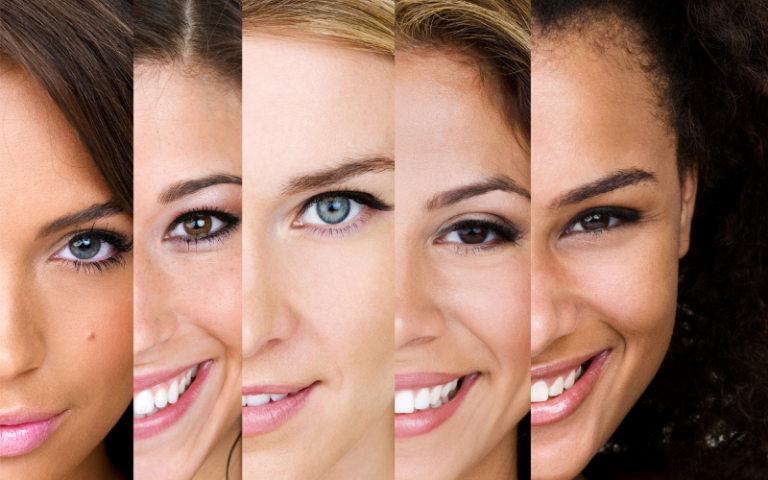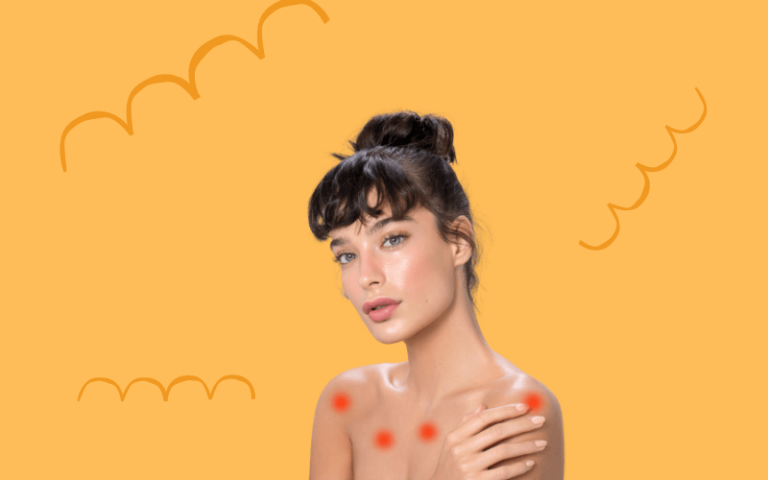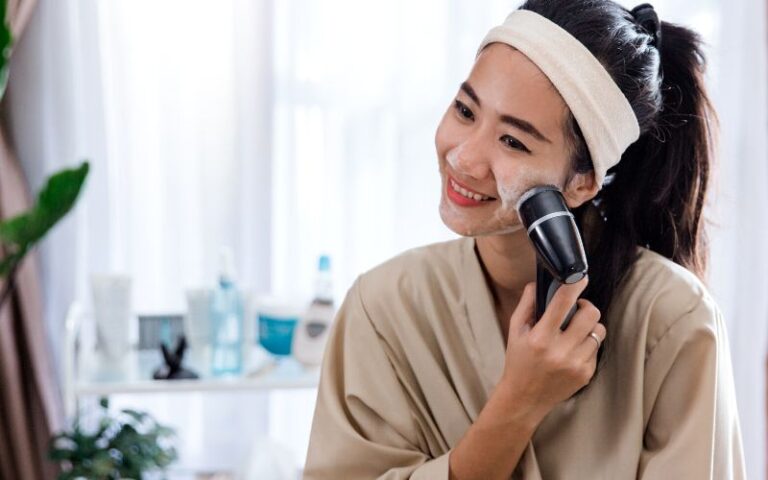Derm Formulates The Exact Skincare Routine For Oily Skin — No More Breakouts

Let’s face it, oily skin can be a total buzzkill to your vibe.
Especailly when the excess oil leads to acne breakouts when you least expect it.
While there are a number of different topical treatments that can be used to keep it under control; it’s unlikely your overall skin type is going to change (sigh).
Oily skin is caused by genetics in a lot of people, which you can’t control (1, 2).
But, there ARE a number of factors that can lead to oily skin, such as stress, diet, hormones, and poor hygiene, some of which you CAN control.
Oh yah, we’re going to get into those — Like, right now.
Here’s the best skincare routine for oily skin:
Basic skin care routine
Let’s start off with what you came here for.
There are certain steps that everyone needs to incorporate into their skin care routine.
These are just basic hygiene and most people already perform these steps.
They include using cleanser, toner, moisturizer, and sunscreen.
Not only are the steps important, but of equal importance is choosing the right products.
In order to select the best products, you need to read the ingredient list of all your skincare products.
Here is an example of a basic skin care routine for oily skin:
Morning routine:
- Cleanser
- Toner
- Moisturizer
- Sunscreen
Evening routine:
- Cleanser
- Toner
- Moisturizer
What type of cleanser you’ll need
You must cleanse your skin twice a day with a gentle face wash no matter what skin type you are but especially if you have oily skin.
Make sure you choose a non-comedogenic formula. Cerave and cetaphil make great cleansers for this.
If you sweat throughout the day, it might be a good idea cleanse 3 times a day.
Cleansing is necessary in order to remove the debris, pollutants, toxins, dirt, oil, and sebum, from your skin so they do not clog your pores and lead to acne breakouts.
As oil and dirt buildup in your pores, it also causes blackheads.
People with oily skin often are best treated with foam cleanser or gel face wash instead of lotions or creams.
Cleansing also cleans the skin so that whatever products you use next are well absorbed.
If you don’t have a clean palette to start with, the products you use won’t work as well and you’ll be wasting your time and money.
It is important to use a face wash or foam cleanser with oil controlling ingredients that are gentle so they do not irritate your skin, but are strong enough to win the fight against pesky acne and prevent future breakouts.
Oil cleansing
Oil cleansers can be used as a first step in cleaning the skin. It serves to remove makeup, dirt and oil in a gentle manner.
These oil cleansers are lightweight formulas that consist of non-comedogenic oils, such as sunflower oil, which cleans without making oily skin worse or causing acne (4, 5).
These are the best ways to remove makeup without irritating your skin and are gentler than micellar water.
Oil cleansers can be used with any skin type. In order to achieve the best results, the next step in cleansing would be to use your regular facial cleanser that is geared towards your specific skin type.
Toner
Toner is one of the most misunderstood products… yes, they actually have a purpose.
While they work great for oily skin to reduce facial oil and acne, all skin can benefit from the appropriate toner with the right ingredients for their skin type.
Toners are great at getting rid of excess oil or sebum, dirt, makeup, pollutants, and toxins that your cleanser left behind and will mattify your shiny complexion.
It’s the final step before you apply your other products.
Toners are also great at balancing the skin’s pH level (1). Skin tends to be slightly acidic, so it is important to use products that do not alter this.
Changes in pH can affect the skin’s barrier function.
If the integrity of your barrier is compromised, your skin will experience moisture loss and it will dehydrate.
Also, this loss of barrier function will allow harmful microbes to be able to penetrate into your body and lead to infection.
Finally, skin cells will not slough off as they should and this will clog your pores, too.
Types of toners
Toners with alcohol, witch hazel or hydroxy acids will benefit oily skin types the most, but may not be able to be used by people with sensitive skin.
Hydroxy acids include alpha and beta hydroxy acids (1). The most well known alpha-hydroxy acids (AHA) are glycolic acid and lactic acid.
The only beta hydroxy acid (BHA) is salicylic acid.
These are powerful astringents to dry up the excess oil on your skin to help give your face a more matte finish.
They are also powerful exfoliating agents that help prevent and treat acne while smoothing the surface of the skin and removing hyperpigmentation/dullness.
Salicylic acid also has anti-inflammatory properties to decrease redness and inflammation of the skin.
Hydroxy acids also are available in moisturizing creams, cleansers, and serums.
AHA’s are also a great way of delivering anti-aging benefits, such as decreasing fine lines and wrinkles as well as the appearance of pores.
Moisturizer
Every skin type needs to deliver moisture to their skin with the right products twice a day, even people with oily skin.
Most people think that you should not use a daily moisturizer if you have oily skin because it will make it worse.
In fact, oily skin needs hydration just as much as dry skin and sensitive skin do.
If you don’t apply moisturizer to oily skin, your skin will think it needs moisture and secrete more oil to compensate.
This will worsen your oily skin and give you even oilier skin. Yikes, no thanks.
The right type of moisturizer
It is important to use the right ingredients when you have oily skin.
You want to stick to lightweight lotions or gels that are oil-free and non-comedogenic, especially when using a daytime gel moisturizer (1).
Heavy cream-based moisturizers , especially during the day, will treat the dryness but make your skin greasier, while gel moisturizers will deliver lightweight moisture without the grease.
Humectant moisturizers, like hyaluronic acid or glycerin, work really well for oily skin types.
Hyaluronic acid and glycerin can deliver lightweight moisture to the skin, which treats dryness without making it greasy.
Sunscreen
The use of sunscreen is important for every skin type and one of the best things you can do for your skin. It is a critical step in your skincare plan, and usually the final step.
Exposure to the harmful UV rays from the sun can lead to wrinkles, hyperpigmentation, and skin cancers.
You should use a lightweight sunscreen that is oil-free.
The sunscreen you choose needs to have broad spectrum UVA and UVB coverage, because both UVA and UVB rays can cause skin cancer.
Sunscreen needs to be applied every day and reapplied throughout the day because one application of sunscreen does not last all day.
The most you can get out of it is a couple of hours if you are not sweating.
It is important to select a sunscreen with a good SPF. SPF, or sun protection factor, is basically a measure of how well the sunscreen protects you against a sunburn by blocking out UVB rays.
What a good sunscreen consists of
SPF should be around at least 50, which will effectively block out 98% of UV.
There are 2 different types of sunscreen: chemical and physical (1).
Chemical sunscreens absorb the UV rays and convert them to harmless heat.
Because they need to be absorbed, they take 30 minutes after applying them before they are effective.
They include ingredients, such as avobenzone and octinoxate.
Physical sunscreens work immediately to create a barrier to prevent UV from being absorbed. They include ingredients, such as zinc oxide and titanium dioxide.
Whichever type you choose, make sure it is a lightweight sunscreen that is oil-free and non-comedogenic.
Advanced skin care routine
Yep, a routine like this may make you feel like a genius scientist.
Beyond the basic steps, there are other important products that you should consider adding to your skin care program.
These can be tailored to your individual needs and specific skin concerns in order to create the best skincare routine for your skin.
Every person’s skin is different and every regimen is different so it is important to read ingredient lists to ensure you select the appropriate products.
Here is an example of an advance skin care routine for oily skin:
Morning:
- Cleanser
- Toner
- Serum
- Acne treatment
- Eye cream
- Daytime moisturizer
- Sunscreen
Evening:
- Cleanser
- Toner
- Serum
- Acne treatment/ retinoid or retinol
- Eye cream
- Night cream
Retinoids
Retinoids are useful for all skin types but especially for oily skin.
Retinoids are a form of vitamin A that can help treat acne by controlling oil production, exfoliating dead skin cells to smooth out the skin, and unclogging pores.
It can also decrease the appearance of pores and give your skin a healthy glow (1, 2, 6).
It is very effective for treating all forms of acne, comedonal (blackheads and whiteheads) and inflammatory, as well as preventing future breakouts.
Retinoids also help with anti-aging by stimulating collagen production, fading dark sun spots/ pigmentation, and by improving skin tone by removing dullness/ imperfections.
It’s also a great way to decrease fine lines and wrinkles to improve the texture of the skin’s surface.
It’s best to start out using it infrequently and slowly build up to every night because of its side effects.
You can also start with over the counter retinoids or retinol before using the stronger prescription strength medications, like Retin A or Tazorac, that need to be prescribed by a dermatologist.
People with sensitive skin may not be able to use prescription strength ones because they are too drying.
Antioxidants
Antioxidants are good for all skin types and are a very important step in skincare.
They scavenge and get rid of free radicals which can damage your collagen and ultimately lead to wrinkles and premature aging (1, 2, 7-9).
Free radicals come from the UV rays of the sun, pollution, smoking, alcohol, and poor diet choices.
These free radicals have an unpaired electron.
So, they are constantly searching for an electron to steal from another molecule.
If they steal it from collagen, it will destroy the collagen.
Antioxidants will donate an electron to the free radicals to neutralize the threat.
Vitamin C is one of the most potent and important antioxidants.
It also aids in collagen production and helps to fade dark sun spots to give your skin a healthy glow. Vitamin E is another antioxidant which also aids in hydration of the skin.
Vitamin E and C are often combined together to create a powerful skin rejuvenating duo!
Eye cream
Eye creams are not just for people with dry skin.
There are a variety of problems specific to the eye area because it is such delicate skin and can be the first to exhibit the signs of aging (1).
These creams can address dark circles, puffiness, wrinkles as well as dry skin.
Lightweight humectant eye creams with hyaluronic acid can hydrate the eye area without making your skin greasy.
Retinol can help decrease lines in this area. No matter which one you choose, make sure it is an oil-free moisturizer and you’ll be good to go!
Night cream
Night time is the perfect time to use nourishing creams instead of just humectants.
This is the final step in your skincare regimen.
All day long your skin is fighting free radical damage, so it does not have time to repair itself. It repairs itself at night when you are sleeping.
That is why getting enough sleep is so important.
If you do not get enough sleep, your skin and body do not have time to repair themselves. Night creams are not just for deep hydration.
They can also contain growth factors and peptides to help in the production of collagen and treatment of wrinkles (1, 10-14).
Peptides can also decrease muscle movement, similar to Botox, to help the appearance of wrinkles, to improve skin’s texture and tone, and to smooth the surface of the skin.
Some creams also have retinol to help with lines as well.
Whatever one you chose, make sure it is an oil-free moisturizer.
Acne treatments
*Don’t* forget to add these.
Benzoyl Peroxide
This is one of the most popular acne treatments on the market.
Benzoyl peroxide (BP) works by decreasing oil production, exfoliating dead skin cells to unclog pores, and killing the bacteria that causes blemishes (1).
It comes in different strengths and can be used twice a day if needed.
They are available as over the counter products or prescription strength medications.
Salicylic acid
Salicylic acid (SA), which is a BHA, accomplishes many of the same tasks that BP does.
In addition to decreasing oil or sebum production and exfoliating dead skin cells to unclog pores, it also decreases inflammation (1).
It is not as harsh as BP and can oftentimes be used twice a day if needed.
Exfoliants
Exfoliating cleansers are important to get rid of dead skin cells so they do not clog your pores and lead to more breakouts.
They can also improve the skin tone, the texture of the skin’s surface, and the appearance of wrinkles (1).
Types of exfoliants
There are 2 types: chemical and physical.
Chemical exfoliants, like alpha-hydroxy acids breakdown the bonds between the dead cells so they can be easily rinsed away.
They can also help decrease oil production.
Chemical exfoliants are usually easier to use and less likely to cause problems. Physical exfoliants usually consist of beads or scrub brushes.
These are much easier to abuse and cause damage to your skin if you are not careful and experienced with their use.
As their name suggests, they physically remove the dead skin to prevent clogged pores.
People with oily skin can usually tolerate exfoliating twice a week.
You have to be careful not to over-exfoliate or scrub too hard, which can cause abrasions to your skin that lead to infections and scars.
7 Natural ingredients to help oily skin
Oh you’re looking to go the natural route huh? We got you.
1. Tea tree oil
Tea tree oil is an essential oil used in the treatment of blemishes (1, 2).
Studies have shown that tea tree is as effective as benzoyl peroxide in treating acne but with less drying and side effects.
Tea tree products also take a little bit longer to get your blemishes under control compared to BP.
2. Aloe vera
Aloe is an antioxidant, anti-inflammatory and anti-microbial agent (1).
It also has the ability to balance the pH of your skin.
Aloe has moisturizing capabilities as well. It has been used in the treatment of acne, burns, wounds, eczema and psoriasis.
3. Licorice
No, we’re not about to tell you to rub Twizzlers all over your face.
Licorice is one of the oldest essential oils used for medicinal purposes (1).
It is an antioxidant, anti-inflammatory and anti-microbial agent. It has been used not only in the treatment of acne-prone skin, but also psoriasis and eczema.
4. Niacinamide
Niacinamide is a derivative of vitamin B3 and has great anti-inflammatory properties (1, 2).
It is useful in treating acne for this reason as well as its ability to decrease sebum production, improve redness and tone of the skin, and exfoliate dead skin cells.
Niacinamide can be ingested or applied topically to get these benefits.
5. Clay
Clay masks are able to absorb large amount of surface oil on your skin to give you a shine free face (17, 18).
The best clay masks contain bentonite or kaolin clay.
Kaolin clay is safe for use even in people with sensitive skin.
Red clay masks are great to absorb face oil in acne prone skin.
6. Charcoal
Activated charcoal used in face masks can absorb excess oil as well as exfoliate dead skin (18, 19).
Charcoal has been used for many years in emergency rooms to treat overdosed or poisoned patients.
It absorbs poisons in the stomach just like it absorbs face oil.
Face masks are great at trapping highly concentrated ingredients, like charcoal or clay, on the skin and allow them to penetrate better.
7. Witch hazel and papaya
These are potent astringents which are capable of removing excess oil from the skin, which in turn can help decrease acne breakouts and give your face a matte finish (1, 2, 15, 16).
Other notable natural remedies
- Soy: Soy can also decrease oil production which is useful in the treatment of acne (2).
- Zinc: Zinc is a good anti-inflammatory agent which can help with blemishes (2). You can take it orally or apply it topically to get the benefits for acne-prone skin.
- Green Tea: Green tea is a potent anti-oxidant, anti-inflammatory, and chemopreventative agent (1, 2). It contains contains epigallocatechin-3-gallate (EGCG) which actually inhibits excess sebum production.
- Chamomile: Chamomile is a great ingredient to balance skin hydration and control oil production (1). It also has anti-inflammatory effects to calm and soothe the skin.
- Jojoba oil: Jojoba oil is a non-comedogenic oil that can moisturize the skin without clogging your pores (20, 21). In fact, it actually decreases excess oil production.
- Eucalyptus: Eucalyptus decreases excess sebum production by reducing the size of the oil glands (22). This helps not only to control oily skin but also can help to treat acne.
- Sulfur: Sulfur removes surface oil and skin cells to unclog pores (1). It also is anti-microbial to help treat acne. Some people with sensitive skin may find sulfur too drying.
- Algae: Algae helps to regulate the production of sebum thereby reducing excess oil production by the glands (23-25). It is also a powerful antioxidant to protect the skin from UV damage.
Why do I have oily skin?
Oily skin can appear on your forehead, cheeks and rest of your face.
If you are oily just on your forehead, nose and chin (T zone), you may have combination skin.
Combination skin can be treated with products for oil control in the T zone area and products for dry skin on the rest of your face.
Oil is produced in the sebaceous glands, which are attached to your hair follicles (3). When your sebaceous glands receive the proper signals, they secrete oil on the top of the skin through your pores.
Secretion of natural oils is necessary for skin health because it serves to protect, lubricate and moisturize the skin.
The problem occurs when there is an overproduction of natural oils which leads to too much oil on the skin. Too much oil can clog the pores leading to blackheads and acne.
Ingredients matter
It is important to select the best skincare products for your skin, no matter what skin type you have.
Reading your products’ ingredient lists is critical to ensure you are using the correct products so they will not harm your skin.
Whatever skin care routine you adopt to help your complexion, the key to success is patience and consistency.
If you need help creating your daily skincare routine, you should consult with your dermatologist.
Products to avoid if you have acne and oily skin
Using the wrong skincare products can worsen your breakouts. It’s important to read labels and ingredient lists and choose the best products with the right ingredients for oily skin.
Here are some ingredients that people with oily skin should avoid:
Petrolatum, silicones, and mineral oil
These are oily, occlusive types of moisturizers which can clog pores and lead to worsening of your breakouts.
They are great moisturizers, just not for oily or acne prone skin.
Parabens
Parabens can be irritating to some people and are thought to possibly disrupt female hormones leading to an increased risk of breast cancer.
They can also worsen UV damage.
Sulfates
Sulfates are irritants as well and can clog pores and worsen acne.
Many people can be allergic to these ingredients.
Dyes, fragrances, propylene glycol, lanolin, formaldehyde releasers
These can also be irritants and even cause allergic reactions.
Fragrance-free products are preferable to unscented products because unscented ones contain added scents to cover naturally occurring odors from the ingredients.
Final thoughts
Oily skin is a very common but difficult problem to treat because it is caused in part by genetics.
Picking the correct skin care products with the right ingredients is crucial to the success of your skin care regimen!
There are some basic steps that everyone should perform in their daily skincare routine as well as some advanced ones that can be tailored to your specific needs.
Selecting skin care products and reading ingredient lists can be a daunting task.
If you need help improving your complexion and want to take the guesswork out of your beauty routine, the good news is that you can always seek guidance from your dermatologist who can help you create the best skincare routine for your skin.
- Baumann L (ed) 2015. Cosmeceuticals and Cosmetic Ingredients. McGraw-Hill Education, NY.
- Draelos ZD (ed) 2005. Cosmeceuticals. Elsevier Inc, NY.
- Montagna W, Parakkal P. 1974. Structure and Function of the Skin. Elsevier Inc, NY.
- Danby SG, et al. Effect of olive and sunflower seed oil on adult skin barrier. Pediatr Dermatol. 2013; 30: 42-50.
- Calgary S, et al. The effect of sunflower seed and almond seed oil on preterm infant skin. Adv Skin Wound Care. 2020; 33: 1-6.
- Riahi RR, Bush AE, Cohen PR. Topical Retinoids: Therapeutic Mechanisms in the Treatment of Photodamaged Skin. Am J Clin Dermatol. 2016 Jun;17(3):265-76.
- Farris PK. Topical vitamin C: a useful agent for treating photoaging and other dermatologic conditions. Dermatol Surg. 2005 Jul;31(7 Pt 2):814-7; discussion 818.
- Thiele JJ, Hsieh SN, Ekanayake-Mudiyanselage S. Vitamin E: critical review of its current use in cosmetic and clinical dermatology. Dermatol Surg. 2005 Jul;31(7 Pt 2):805-13; discussion 813.
- Masaki H. Role of antioxidants in the skin: anti-aging effects. J Dermatol Sci. 2010 May;58(2):85-90.
- Creely JJ, DiMari SJ, Howe AM, Hyde CP, Haralson MA. Effects of epidermal growth factor on collagen synthesis by an epithelioid cell line derived from normal rat kidney. Am J Pathol. 1990 Jun;136(6):1247-57.
- Kim, D., Kim, S. Y., Mun, S. K., Rhee, S., Kim, B. J.”Epidermal growth factor improves the migration and contractility of aged fibroblasts cultured on 3D collagen matrices”. International Journal of Molecular Medicine 35, no. 4 (2015): 1017-1025.
- Kähäri, Veli-Matti & Niinikoski, J & Vuorio, Eero. (1987). Epidermal growth factor increases collagen production in granulation tissue by stimulation of fibroblast proliferation and not by activation of procollagen genes. The Biochemical journal. 247. 385-8. 10.1042/bj2470385.
- Aldag C, Nogueira Teixeira D, Leventhal PS. Skin rejuvenation using cosmetic products containing growth factors, cytokines, and matrikines: a review of the literature. Clin Cosmet Investig Dermatol. 2016;9:411-419
- de Araújo R, Lôbo M, Trindade K, Silva D, F, Pereira N: Fibroblast Growth Factors: A Controlling Mechanism of Skin Aging. Skin Pharmacol Physiol 2019;4:275-282.
- Pazyar N, Yaghoobi R, Rafiee E, Mehrabian A, Feily A. Skin wound healing and phytomedicine: a review. Skin Pharmacol Physiol. 2014;27(6):303-10. doi: 10.1159/000357477. Epub 2014 Jun 27. PMID: 24993834.
- Khan H, Akhtar N, Ali A. Effects of Cream Containing Ficus carica L. Fruit Extract on Skin Parameters: In vivo Evaluation. Indian J Pharm Sci. 2014 Nov-Dec;76(6):560-4. PMID: 25593393; PMCID: PMC4293691.
- Williams LB, Haydel SE. Evaluation of the medicinal use of clay minerals as antibacterial agents. Int Geol Rev. 2010 Jul 1;52(7/8):745-770.
- Cortez JSA, Kharisov BI, Quezada TES, Garcia TCH. Micro and nonporous materials capable of absorbing solvents and oils reversibly: the state of the art. Pet Sci. 2017; 14: 84-104.
- Villarreal J, Kahn CA, Dunford JV, Patel E, Clark RF. A retrospective review of the prehospital use of activated charcoal. Am J Emerg Med. 2015 Jan;33(1):56-9.
- Pazyar N, et al. Jojoba in dermatology. G Ital Dermatol Venereol. 2013; 148: 687-91.
- Meier L, et al. Clay jojoba facial mask for lesioned skin and mild acne. Forsch Komplementmed. 2012; 19: 75-9.
- Bhatt, D. & Sachan, A. & Jain, Sparsh. (2011). Studies on inhibitory effect of eucalyptus oil on sebaceous glands for the management of Acne. Indian Journal of Natural Products and Resources. 2. 345-349.
- Kim JH, Lee JE, Kim KH, Kang NJ. Beneficial Effects of Marine Algae-Derived Carbohydrates for Skin Health. Mar Drugs. 2018 Nov 21;16(11):459.
- Thiyagarasaiyar K, Goh BH, Jeon YJ, Yow YY. Algae Metabolites in Cosmeceutical: An Overview of Current Applications and Challenges. Mar Drugs. 2020 Jun 19;18(6):323.
- Pangestuti R, Siahaan EA, Kim SK. Photoprotective Substances Derived from Marine Algae. Mar Drugs. 2018 Oct 23;16(11):399.





